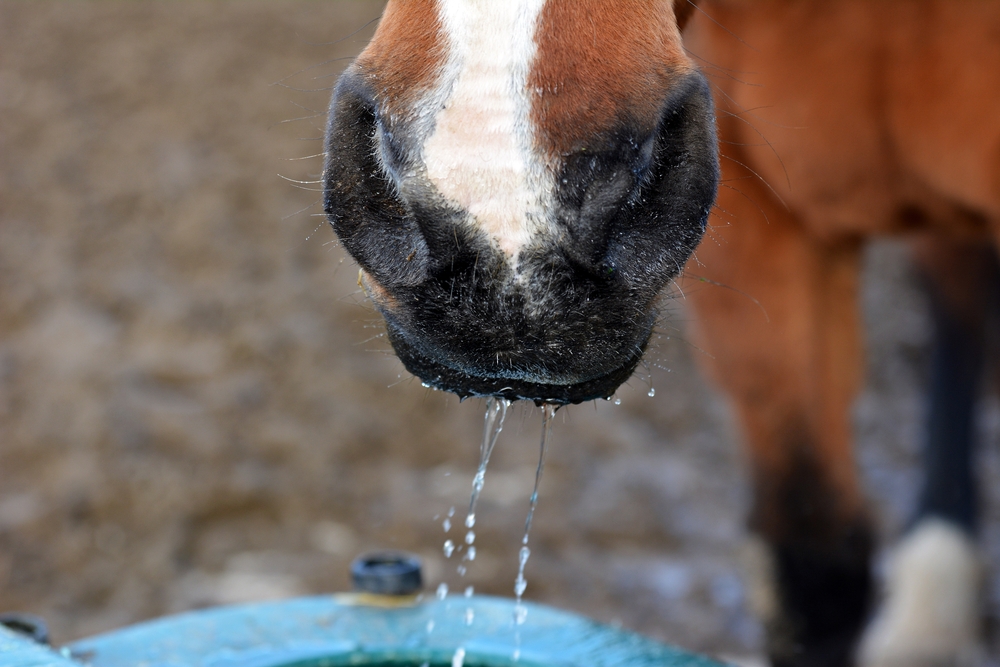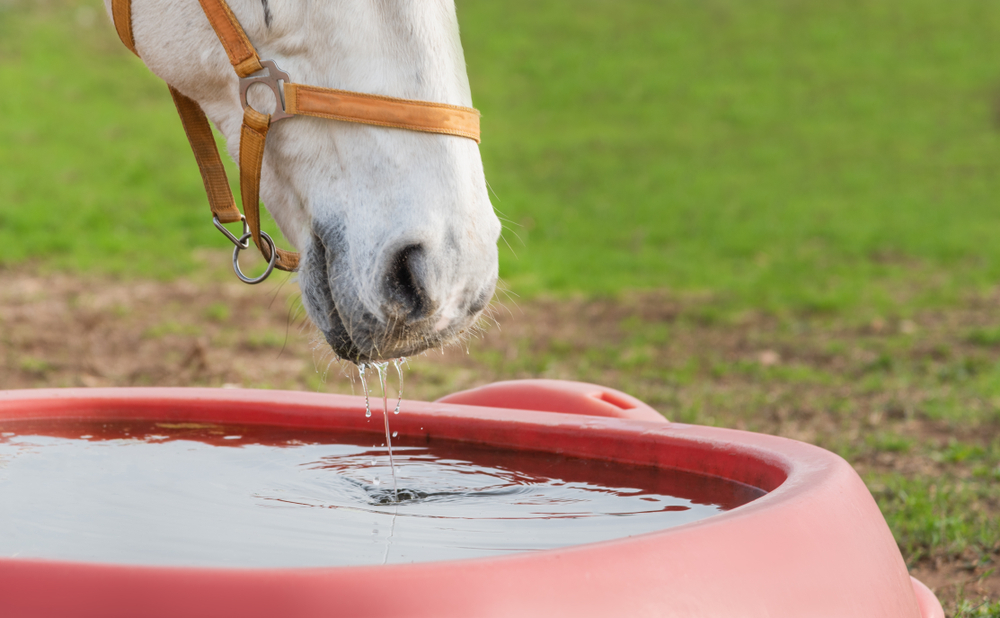Tuesdays with Tony
One of the best ways to keep your horse healthy is to make sure he stays hydrated. Good hydration can keep him performing well, help his organ systems function, and reduce the chance of colic. But have you noticed that self-preservation is not one of your horse’s best skills? Many of them don’t drink enough water when they’re traveling, in a new place, or when the weather changes. Not that I blame them – my fine feline tastes make me picky about flavors too.
In the summer, your horse needs to drink to replace water lost during sweating and exercise. In the winter, he is probably eating more dry food material like hay, and less moisture-rich grass. Dehydration can result, because his food is naturally drier and there is less stimulus to drink when its cooler outside. My docs have seen a lot of colics lately with the weather changing. An average sized (1000 lb) horse should drink about 5-10 gallons of water a day, so keep a close eye on how much yours is consuming. Here are some tips to encourage him to drink more, whether it’s summer or winter.
- Provide fresh water
Make sure your horse’s water source is always fresh and clean. Check all your water troughs, buckets, and automatic waterers daily. Replace the stale water and scrub all your water sources out regularly. Algae can grow quickly around here, and debris can fall into the containers and rot. Even worse, I’m sure you have all seen the dreaded pile of manure accidentally deposited in the water bucket – gross! Your horse is sure not going to drink that.
- Think about the water container
Some horses are picky about what they will drink from. Some drink better out of a trough or larger bucket. If the bucket feels too narrow to him, he may not want to put his nose in. Make sure there’s no metal hardware or handle that might be in his way. Offer him several container options to keep him drinking well. But, it’s best to get him used to drinking from more than one type of container. If he only has a trough at home and you’re away at a show where he has no choice but a water bucket, he may not drink enough.
You’ll also want to provide at least 2 sources of water for your horse, in case something happens to one of them. For example, a bucket could tip over, an automatic waterer could break, or the dreaded pile of manure in the bucket could occur.
- Flavor the water
Some horses can be encouraged to drink by offering flavored water. We use this strategy more for certain occasions like traveling to shows or on extra cold days, rather than on a daily basis. But when you need it, this can work great! Any time you are concerned your horse might not be drinking enough, you can give it a try.
There are a variety of flavorings that can be used. My favorite is to put 3 handfuls of whatever grain your horse loves in the bottom of a full water bucket – I call that “Sweet Tea”. Many horses love the taste of grain-flavored water and will drink the full bucket to get to the small amount of grain in the bottom. Other flavor options include Gatorade, apple juice, a little molasses, or even peppermint oil. Every horse will have different tastes, so experiment with what your horse likes. Always provide plain, unflavored water as well, in case your horse doesn’t like the flavored water. Check with my docs before doing this if your horse has any metabolic disease, insulin dysregulation, or history of laminitis and might not be able to tolerate extra sugar in his diet.

- Bring water from home when traveling
Many horses get used to the flavor of their usual water at home, and don’t drink as well when the water tastes or smells different at a new place. An option is to bring water from home in a water tank or plastic containers so he can drink the same water he is familiar with. Another way is to disguise the flavor of the new water by getting your horse used to drinking water flavored with grain/apple juice/Gatorade like we just discussed in #3, and add the same flavoring to the new water. Hopefully he won’t be able to tell the difference.
- Position the water near the food
If your horse must leave his food to go to his water source, he may be less inclined to drink. Most horses are all about the food! Make it easy for him to take sips while he’s eating by placing his water close to where he is fed. The food going through his GI tract will have more moisture in it, reducing the chance of an impaction.
- Soak hay and grain
Wetting down your horse’s hay and grain can get extra water into your horse’s system. You don’t have to soak the hay for a long time before feeding it – even spraying it down just before feeding can help increase its water content. You can add a little water to your horse’s grain as well, to make it a mash or soup consistency. Bonus, this helps to decrease the chance of choke and suppresses dusty respiratory allergens too.
- Warm the water in colder weather
Some studies have shown that in cold weather, horses will drink more warm water than cold water. If its chilly out, or if you live somewhere that water freezes (Oh the horror!), considering offering your horse warm water.

- Supplementing with salt
Adding a small amount of salt to your horse’s diet can stimulate his thirst and encourage him to drink more. Start by adding 1-2 teaspoons of table salt (sodium chloride) to his grain 1-2 times a day. If you find that his water consumption has increased and he is better hydrated, you can slowly increase the amount of salt up to a maximum of 1-2 tablespoons daily. If he isn’t drinking more than before, stop the salt and try a different method.
There are a couple of situations where salt supplementation shouldn’t be used. Don’t give salt when your horse won’t have access to water for a while, like when he is traveling a long distance. That could actually cause him to become more dehydrated if he’s not able to drink. While diseases that require sodium restriction aren’t common in horses, it’s best to check with one of my docs before adding salt to your horse’s diet, especially is he has any existing health conditions.
Give these ideas a try and find out what works best for your horse. Then comment on my facebook post to tell us what your favorite strategy is! As always, if you have any questions, my docs are happy to talk.
Until next week,
~Tony
P.S. Have you been to my YouTube Channel lately? There are new videos going up every couple of weeks these days, with tons of great horse stuff. I know you humans are into that sort of thing, and I don’t want you to miss out. You’re welcome.
Tuesdays with Tony is the official blog of Tony the Clinic Cat at Springhill Equine Veterinary Clinic in Newberry, Florida. If you liked this blog, please subscribe below, and share it with your friends on social media! For more information, please call us at (352) 472-1620, visit our website at SpringhillEquine.com, or follow us on Facebook!
[jetpack_subscription_form title="Subscribe to Whinny's Wisdoms"]

